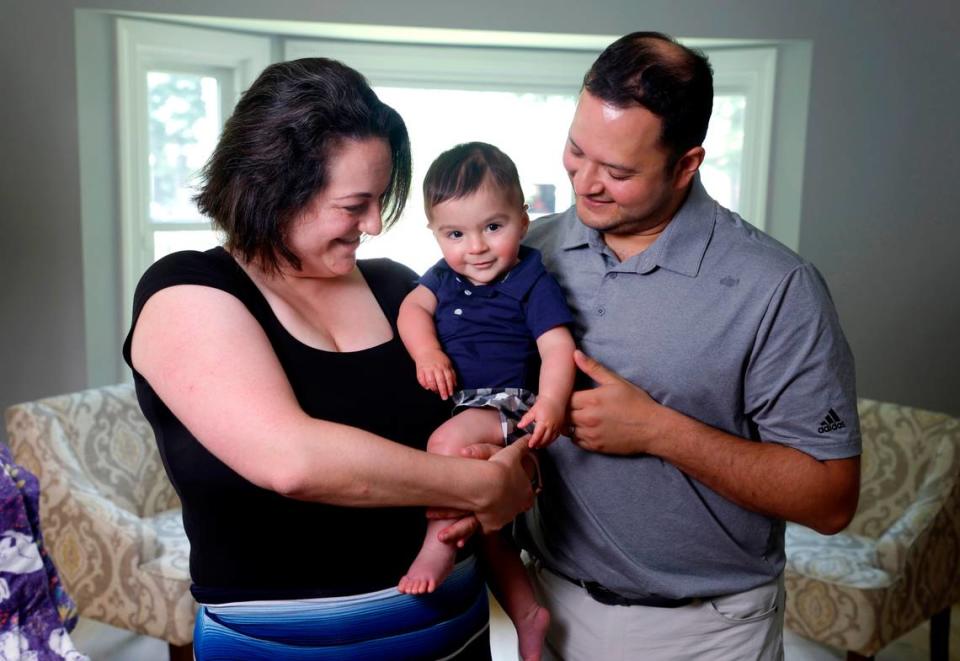Despite decline in pregnancy-related deaths in NC, numbers remain near 5-year high
Fewer women in North Carolina died from pregnancy-related complications in 2022, though these deaths remain much higher than in the years before the COVID-19 pandemic.
New mortality data released in early May by the Centers for Disease Control and Prevention show the United States overall saw a dip in pregnancy-related deaths since 2021, the year widespread vaccination against COVID-19 first began.
Initially delayed nationwide for months due to a reporting problem that originated in North Carolina, the numbers show the rate of pregnancy-related deaths here far outstrip the U.S. overall. And they underscore a persistent disparity between the deaths of white and Black women in the state.
In 2022, 63 women died from pregnancy-related complications in North Carolina, according to a News & Observer analysis of the CDC data. That’s down from 82 pregnancy-related deaths in 2021.
But North Carolina’s pregnancy-related death rate is about 18 points higher than the United States overall.
A joint investigation by The News & Observer and The Charlotte Observer last year detailed how pregnancy can be more dangerous for women in North Carolina — and why experts remain worried about maternal health trends in the state.
Though small in raw terms, experts say the high rate of death relative to the rest of the United States, where pregnant women already fare worse than in other wealthy nations, is a “canary in a coal mine” for broader healthcare failures.

While they acknowledge a year-over-year decrease is good news for North Carolina, maternal health clinicians and researchers who reviewed The N&O’s findings this week said it’s hard to know if the state is truly trending in the right direction.
“If I were in the health department, I would be very concerned,” said Marie Thoma, an associate professor of family health at the University of Maryland School of Public Health.
Will downward trend continue? Experts aren’t sure
Like in other states, some of the decline in pregnancy-related death from 2021 to 2022 in North Carolina is likely due to the corresponding decline in overall mortality as more people developed immunity to the worst effects of COVID-19, Thoma said.
The CDC numbers show some evidence of that: deaths during or within six weeks of pregnancy — when women are most vulnerable to COVID — dropped by almost 40%. Deaths from six weeks to a year after pregnancy, meanwhile, remained essentially unchanged.
One of the persistent problems is the lack of contact healthcare providers have with patients after a pregnancy, according to Hendrée Jones, a professor of obstetrics and gynecology at the UNC School of Medicine. She said such appointments are critical for detecting and treating health problems.
The World Health Organization recommends four appointments within eight weeks after a pregnancy, she said.
“We don’t come anywhere close to that,” Jones said.
She said Medicaid is set up to provide bundled payment to hospitals for prenatal services and delivery. But the incentives for postpartum care, Jones said, just aren’t there.
Given that pregnancy-related deaths in North Carolina were on the rise even before COVID, Thoma said that increase may continue with the pandemic emergency now over.
“Is it just continuing an upward trend happening pre-COVID?” Thoma said. “It looks like that might be happening.”
Disparities persist for Black women
In a report released in early May, the CDC said that fewer Black, white and Hispanic women died from pregnancy–related complications nationwide from 2021 to 2022.
But the agency also noted that the death rate for pregnant or recently pregnant Black women remains much higher than other racial groups.
In North Carolina, Black women in 2022 died of pregnancy-related complications at more than twice the rate of white women, an N&O analysis shows.
The state is working with providers and local health departments on a number of programs to reduce these disparities, said Belinda Pettiford, who heads the N.C. Division of Public Health’s Women, Infant and Community Wellness Section
Many of these efforts, Pettiford said, look beyond medical needs to social determinants of health — such as affordable housing, transportation, even access to healthy food — for people on Medicaid. The low-income insurance program covers more than half the babies born in North Carolina every year.
She said infant and maternal health advocates are also pushing lawmakers to expand Medicaid reimbursement to cover services for doulas, a move the state’s Child Fatality Task Force recently asked state lawmakers to fund during their short session this summer. Workers in those nonclinical roles, who provide guidance and support for expectant mothers, can contribute to healthier pregnancies and faster treatment if something goes wrong, experts say.

For doctors and other providers, Pettiford said state health officials are continuing to raise awareness about pregnancy-related complications signaled by early warning signs such as severe pain, extreme swelling or persistent headaches. Given that the vast majority of pregnancy-related deaths are preventable, she said taking women’s concerns seriously can save lives.
“If she says something doesn’t feel right, you need to listen,” Pettiford said. “It’s about paying attention and providing respectful care.”
Experts still waiting for answers
Assessing whether those efforts will help reduce maternal mortality across the state, though, will take time.
Pettiford said that state health officials are awaiting preliminary data for 2023 that in the coming weeks on near misses that almost result in death — known as severe maternal morbidity — that may provide some evidence the risks to women are improving in the state.

The N&O reported last year that those near misses were, like pregnancy-related deaths, also generally on the rise through 2022.
More than 1,000 women nearly died from pregnancy-related complications that year — at rates much higher than the period before the pandemic.
“We’re just trying to figure out if we’re going to see a downward trend sometime soon,” Pettiford said. “The challenge is: we don’t know.”
More signals on the drivers and trends of North Carolina’s pregnancy-related deaths are expected to emerge from the state’s maternal mortality review committee. The all-volunteer group of clinicians and advocates closely analyzes the deaths of pregnant and recently pregnant women case by case
The reviews consider deaths from other factors like overdose and domestic violence and are far more expansive than those based on CDC data, which relies solely on death certificates from each state.
But MMRC reports tend to lag behind for years — and North Carolina is further behind than most.
North Carolina’s MMRC released its latest study earlier this year on deaths from 2018 and 2019. Pettiford said the committee is currently working to review deaths during 2020 and 2021 in an effort to get caught up.
Ultimately,the CDC data does show cause for concern in North Carolina, especially as the state compares to the rest of the country, Jones said.
But she sees some potential bright spots.
After extending postpartum Medicaid coverage from two to 12 months back in 2021, the legislature finalized the overall expansion of Medicaid coverage for patients starting in late 2023. More insurance coverage will mean more access to medical care and treatment, which experts hope will mean women are healthier even before they get pregnant.
It may take years for data on pregnancy-related deaths to reflect those impacts.
“I do not have a crystal ball,” Jones said. “But I’m hopeful they’ll continue to trend down.”
Pregnancy-related deaths open voids in families expecting to celebrate new life

